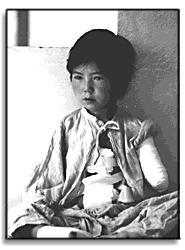 |
 |
||||||
Afghanistan: Angola: Nicaragua: Mozambique: Bosnia & Herzegovina: Combodia.
What effects it has on Society An Inisible Barrier in Development
|
 Wars end but Landmines Don't In Cambodia they are known as the "eternal sentinels". Landmines are hidden indiscriminate killers. They cannot tell the difference between the footsteps of a soldier or a child. They continue to kill and maim long after wars are over. Throughout the world there are more than 344 types of anti-personnel (AP) mines produced by over 100 companies in 52 countries. Generally speaking there are two types of AP mines: blast mines and fragmentation mines. Blast AP mines are often less than 10 centimetres in diameter and are activated by the weight of a foot. "Bounding mines" are fragmentation mines that jump into the air before exploding, spraying fragments across a large area. Other fragmentation mines include the American "Claymore" which is activated by a trip-wire, projecting shards of metal in the direction of the victim. One of the most insidious mines is the "butterfly" mine -- a blast mine designed to look like a toy but which explodes when played with. Used by militaries throughout the world, their low cost and easy deployability have made landmines a weapon of choice in the world's poorest countries. In countries such as Angola, Mozambique, Afghanistan, Cambodia, and Bosnia, landmines are a terror ordinary people live with every day. On average, 500 people fall victim to landmines every week. Since 1975, there have been
more than one million casualties; the majority of which have been civilians -- many of
them children. Where they do not kill immediately, landmines severely maim their victims,
causing trauma, lifelong pain and often social stigma. Worldwide there are some 250,000
landmine amputees. The widespread use of anti-personnel (AP) mines has created a
humanitarian crisis of global proportions. While current assessments place the number of
mines deployed throughout the world at somewhere between 60 and 100 million, this remains
a rough estimate since few accurate records were kept when the mines were deployed. In
Afghanistan, for example, millions of AP mines were scattered indiscriminately out of the
backs of airplanes and trucks. AP mines cost between US$3 and US$30 to purchase: it costs
between $300 and $1000 to remove a single mine. The costs to clear those mines already
deployed will be in the billions. |